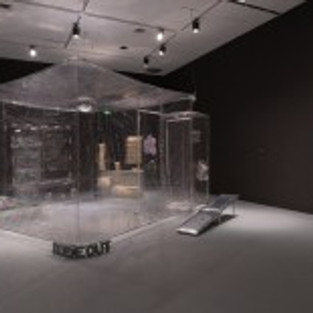
Forms and Identity. Orange County Museum of Art. Photo Courtesy of OCMA.
The Shift Toward Identity:
Female Artists of the 1990s
By Evan Senn
Through April 2nd
Walking into the silent white space of the Orange County Museum of Art (OCMA) and through the gallery doors, my eyes and heart were searching for some palpable relief and understanding in the frustrated female perspective. In this tumultuous day and age, feminism is both a source of comfort and bonding between women and men, and a source of contention as well. The political and social future of our country is unknown and that uncertainty is scary. However, there is some relief as we collectively look toward each other and back into history to find solution, patience and for some of us, a drishti—a focal point to keep us balanced—in an anxious time. OCMA’s latest exhibit “Forms of Identity: Women Artists in the ’90s” offers a familiar feeling and not-so-distant historical vantage point on how personal and political intersect within the scope of feminism. Specific attention is paid to how feminist artists dealt with the tumultuous time of the 1990s. This vantage point has a nuanced power that offers a perfect drishti for our current state of woe with the tumultuous waves of uncertainty all around us.

Forms and Identity. Orange County Museum of Art. Photo Courtesy of OCMA.
This intimate and insightful look at the evolving feminist expression in “Forms of Identity” is particularly fascinating for art lovers and history buffs alike. The 90s were a unique and stylistically expressive era, and while the ’60s and ’70s cast feminism in a louder tone and brighter spectacle, the ’90s turned feminists to look more introspectively. With some improvements given to the fight for equality during the ’60s and ’70s, by the time the ’90s rolled around, feminism was expected to be loud, so instead the artists became quiet, more poetic and more reflective.
The female artists in this exhibition all worked in the 1990s and all addressed topics surrounding the self. Artists like Millie Wilson, Laura Aguilar, Liz Craft and Dawn Fryling demanded my attention above all else, through their subtle, thoughtful and vulnerable artworks in “Forms of Identity,” giving a sense of that inherent power that lies within the quiet melancholy of this era. The postmodern tendency during the ’90s nudged artists to consider not just equality between men and women but to also consider culture, race and gender identity politics, personal expression, and marginalization within womanhood and feminism.
Aguilar’s Clothed/Unclothed #16 examines the medium of photographic portraiture to depict different experiences beyond the white, heteronormative body ideals found in mainstream images of women and men. Her photographic counter narratives are fascinating, sensitive and intimate.
Artists Jacci Den Hartog, Dawn Fryling, Helen Pashgian and Linda Stark asserted their individuality by ignoring the expectations of their craft or gender and gained notoriety by creating works with unconventional materials, deliberately emphasizing the formal properties and innovative uses of their materials. Jessica Bronson and Diane Gamboa approached nuanced aspects of culture, race,and gender identity through their art, and Leslie Brack, Rachel Lachowicz, Erika Rothenberg, Alexis Smith and Millie Wilson investigated the construction of the female identity in mainstream culture.
Rachel Lachowicz’s Homage to Carl Andre is a material dense, emotionally charged abstract piece made with lipstick and wax pigments to create a kind of chess board, mimicking Andre’s 1969 piece Magnesium and Zinc. With both its materials and its somewhat messy appearance referencing an alternative perspective, Andre’s perfectionism and his affiliation in his wife, Ana Mendieta’s murder, is negated through a different vantage.
Dawn Fryling’s Fence Bundles utilize chain link in an interesting way that repurposes its fencing properties to create her own kind of fence or wall, reminding us of all the barriers we face, internally and externally. Alexis Smith evokes a passive aggressive nature with her work, Valedictorian, a mixed-media collage science and math-related imagery, mixing and mingling with lingerie ads and a line of text reading “it’s not easy being easy,” recalling societal expectation of women, and the hardship of trying to make a name for yourself in the math and science industries as a female, even when you’re the valedictorian of your class. Erika Rothenberg’s five heart-pies in Love Story #2, gives us an emotional story with simple snippets from one perspective of a love story with text inside each heart pie, also full of paper that from far away looks like muscle, making viewers consider the dichotomies between love, lust, cooking, consuming, promises and betrayal. This piece evokes viewers to create their own narrative with the snippets, and asks them to confront their initial responses and question their own biases, with the very little information given to them.
Liz Craft’s Hide Out installation is reminiscent of a bomb shelter or a sensory deprivation room, but suggests a kind of toxicity of the surroundings as well; perhaps recalling the toxic environment of societal opinions, limitations and expectations of women. Hide Out seems to offer a safe space for women, keeping that harmful sexist or misogynistic atmosphere away from the inhabitant of the clear plastic shelter.
Although the myriad work can be jarring, the majority of the work by the artists in “Forms of Identity” are visceral, strong, penetrating, unwavering, inclusive and defenseless as they present themselves to visitors and viewers, not asking for anything in return.
#feminism #DianeGamboa #art #painting #women #Alexissmith #ocma #essicaBronson #female #contemporaryart #womenartists #MillieWilson #southerncalifornia #LauraAguilar #collage #RachelLachowicz #LeslieBrack #ErikaRothenberg #conceptualart #feminist #photography #artgallery #evansenn #museum #orangecountymuseumofart #woman #1990s #artandcake #FormsofIdentity #artexhibition #installation #ArtandCakeLA #fineart #artists #artist #mixedmedia #artreview #identitypolitics #artmuseum #sculpture #artexhibit #LizCraft #ArtandCulture #womanhood #exhibition #identity #postmodern #exhibit #feminine #DawnFryling






















